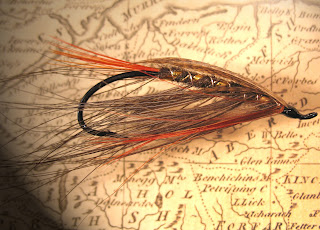 Most of us will fish all day without the slightest consideration of the reasons we fish the fly we do. "It sure worked yesterday" might be the best rational that we come up with. Could yesterday have been a perfect match for that fly that was used at the end of the day that offered just the right light in a depth of water with just the right weight to have the fly traveling at the correct speed in the perfect color and contrast that matches the situation? Take a deep breath..........
Most of us will fish all day without the slightest consideration of the reasons we fish the fly we do. "It sure worked yesterday" might be the best rational that we come up with. Could yesterday have been a perfect match for that fly that was used at the end of the day that offered just the right light in a depth of water with just the right weight to have the fly traveling at the correct speed in the perfect color and contrast that matches the situation? Take a deep breath..........Each and every angling day can be broken into very small segments where perfect may only happen but a few times. My contention is that the more we are willing to have those perfect moments the greater the possibility for a connection.
Dark Light
Each complete fishing day consists of the same start to finish. It's like the "Hippy Dippy Weatherman" routine of the late comedian George Carlin. "Darkness will turn to light and later in the day it will get dark again". Given the fact that a Salmonoid has the ability to see white and black in total darkness and blue as the first and last other color you can have a good opening and closing just by utilizing this information. There are 24 different hues that will be available through the day. With the highest visible color being blue followed by reds and orange and concluding in green you will have a basis of choice. By also taking into consideration the use of these colors as fluorescence you can enhance what a fish can see by changing the spectrum waves and how they pass through and are absorbed by the clarity or increase in tannin in the water. Every water body has a different clarity.
 Shallow Deep
Shallow DeepDuring your day you will encounter water at different depths. Because water has the natural ability to absorb and defuse light, the amount of light will be determined by the depth that it can penetrate the location you are fishing.
Bright Dull
Bright sunshine offers us the greatest array of colors the fish can see. This is when the end range spectrum can be effective. Contrast has the greatest effect. When the day is dull the available colors that will be seen are more in the dawn day to dusk cycle. A bit of flash can be just what is needed to be noticed.
Heavy Light
Simply said we pick the weights, length of leader, weight of fly and size of fly that matches the moment.
Slow Fast
For me the speed that my presentation is traveling can have the greatest effect on getting a reaction. I want my fly moving at the speed the fish want and seeking this piece to the puzzle can be the most difficult of all. Moving at the speed of the water is a good place to start.
Cold Hot
Take the temperature of the water when you arrive. Take it again each hour. If you have a warming trend, even in a quarter of a degree increments you can know that the fish will make short movement to your fly. Remember that on days that are sunny with snow on the ground the rising air temperatures can cause the water to get colder. The other end of the range into very warm conditions will also limit the activity of our quarry. They will seek cooler and shadier locations to spend the day with lower light availability.
Conclusion
In all of the above you will find the basic pieces toward seeking the goal. Give some thought during a day on the water to these physical characteristics might be beneficial. The one constant is contrast. Do we put a red dot on a chartreuse egg because it looks like blood? Or is it the contrast that enables the chartreuse so visible from the background? There is little contrast between red and orange and a great difference between pink and black. Enhancing the go to color with a strong second choice is a very important factor. Incorporating the properties of iridescence, as can be seen in peacock hurl and many synthetics will also give added sparkle. What puzzle lies before us can be analyzed and what can be analyzed may be answered and what can be answered makes us better anglers.
William





